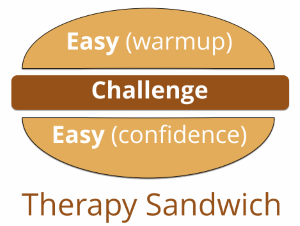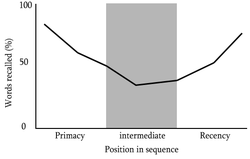Motivating Stroke Survivors with a therapy sandwich
How caregivers can challenge speech-language survivors during treatment, without discouraging them.
 Start
by helping the patient choose the goal: after all it's their
therapy. But some patients start at an over-challenging level and
quickly become frustrated. Or they stay at an easy level & avoid
challenge (which is necessary to make progress.) In those cases,
communicate with the survivor about how they are feeling and what their
goal is. Let them know you are not judging them and are just
helping them navigate those feelings.
Start
by helping the patient choose the goal: after all it's their
therapy. But some patients start at an over-challenging level and
quickly become frustrated. Or they stay at an easy level & avoid
challenge (which is necessary to make progress.) In those cases,
communicate with the survivor about how they are feeling and what their
goal is. Let them know you are not judging them and are just
helping them navigate those feelings.
This three step method warms up the patient with success, then challenges them (this is the meat of the treatment), and then finishes with something easier so they finish with success.
"It really is a good way to do it so you don't get flustered."
- Shirlene Cooper, stroke-survivor
- WARMUP : Find a level that they can succeed at (90-100% accuracy*
). This gets them comfortable with the exercise and how it
works. It also gives them some emotional momentum and confidence.
They'll need that for step 2.
*90-100% is a guideline. The goal is that they feel successful.
- CHALLENGE: Work at a level that is a challenge for them (something around 60-90% accuracy). This is the meat of our Therapy Sandwich and I suggest spending most of the session time at this level. This is where you strain the brain. No strain, not gain. We want to challenge them.
- FINISH WITH SUCCESS: Go back to the level in #1.
The idea here is that they are more likely to remember the success of step 1 and 3 than the challenge of Step 2.
Now that you know how to make Therapy Fun, 
ready for some free
therapy
materials?
Every day is an opportunity for recovery. Don't miss a single day.
- Surprising neuroscience discovery that makes recovery possible at any age.
- Why embracing failure leads to faster recovery.
- Unlock your survivor's communication needs in 4 steps.
- How to improve speech & language at the kitchen table.
Clay Nichols
Co-founder of
MoreSpeech and
Bungalow Software
for unlimited speech therapy at home and in the clinic.
 For
3 decades, Clay has helped patients, caregivers and speech pathologists
with speech & language software. He is not a speech-language
pathologist.
For
3 decades, Clay has helped patients, caregivers and speech pathologists
with speech & language software. He is not a speech-language
pathologist.
© 2025 Bungalow Software
 The Recency Effect causes us to remember the most recent
part of an activity. For example, we'll often remember how felt about
the end of a movie more than the middle.
The Recency Effect causes us to remember the most recent
part of an activity. For example, we'll often remember how felt about
the end of a movie more than the middle.